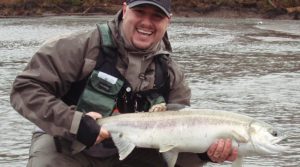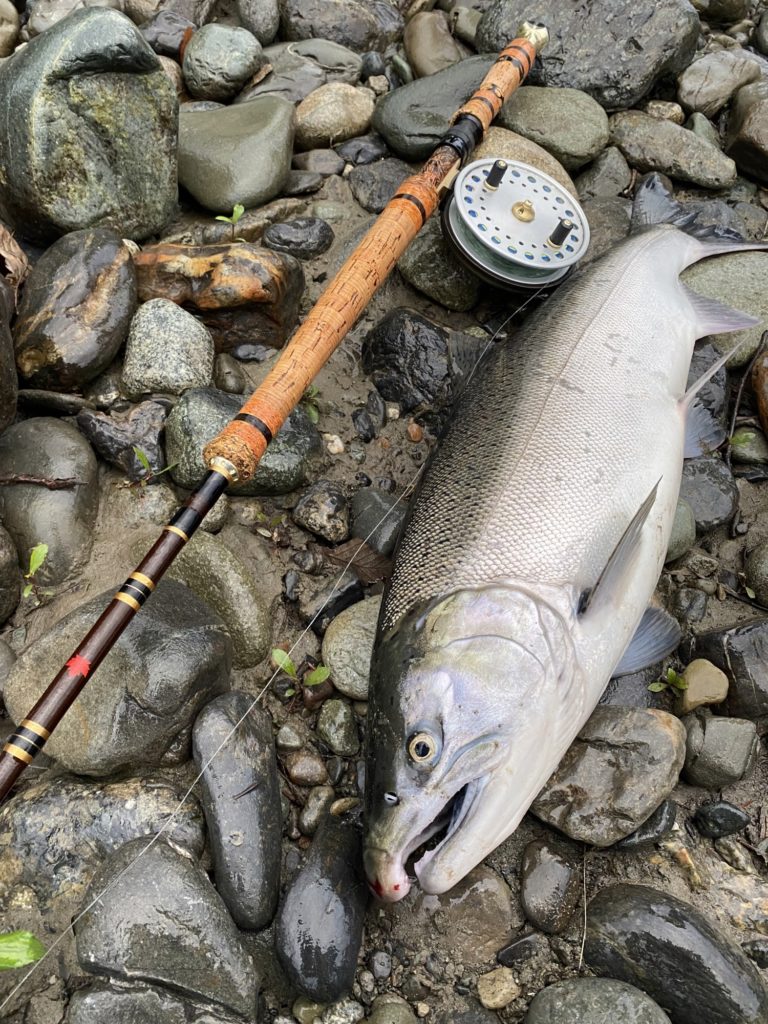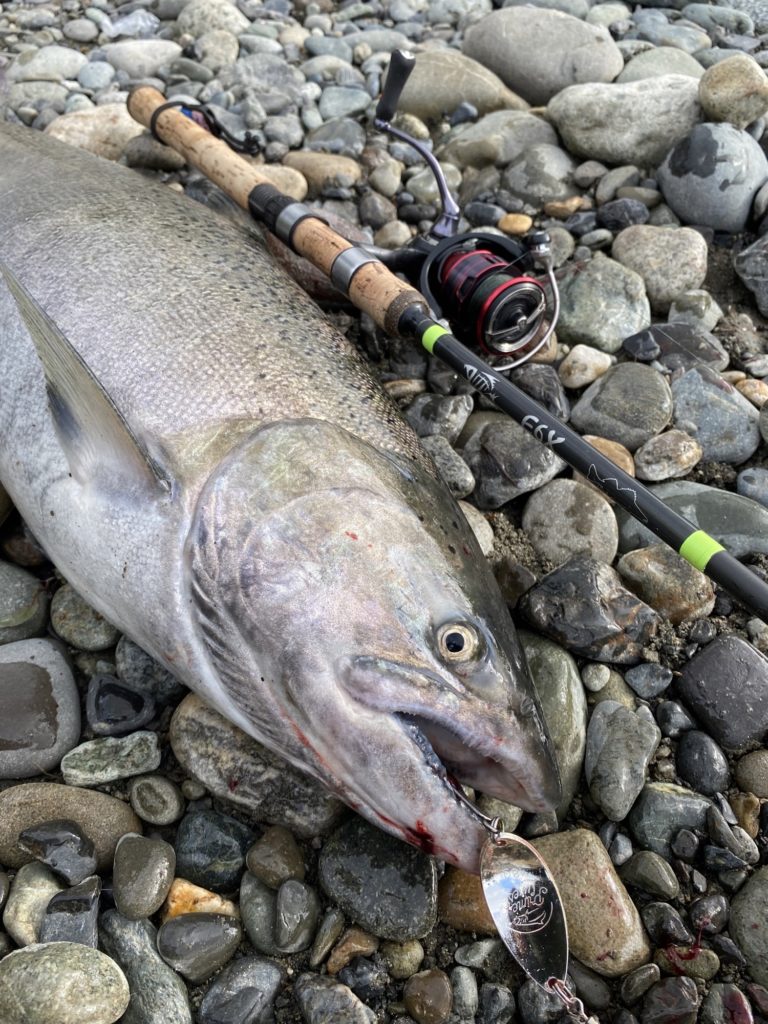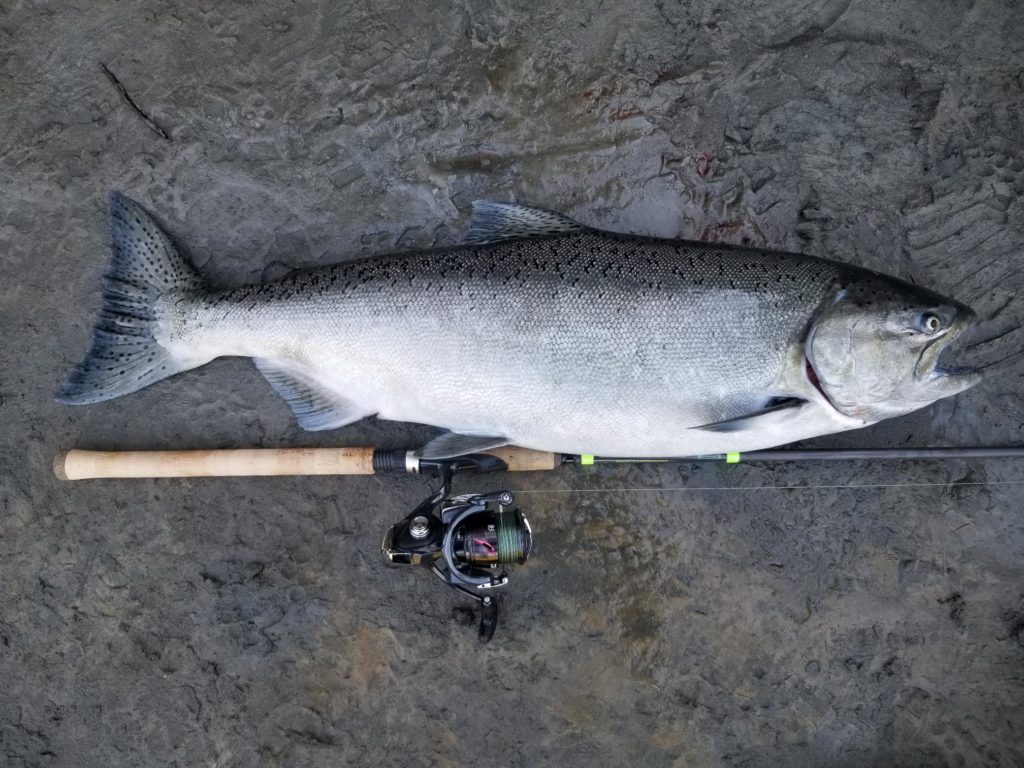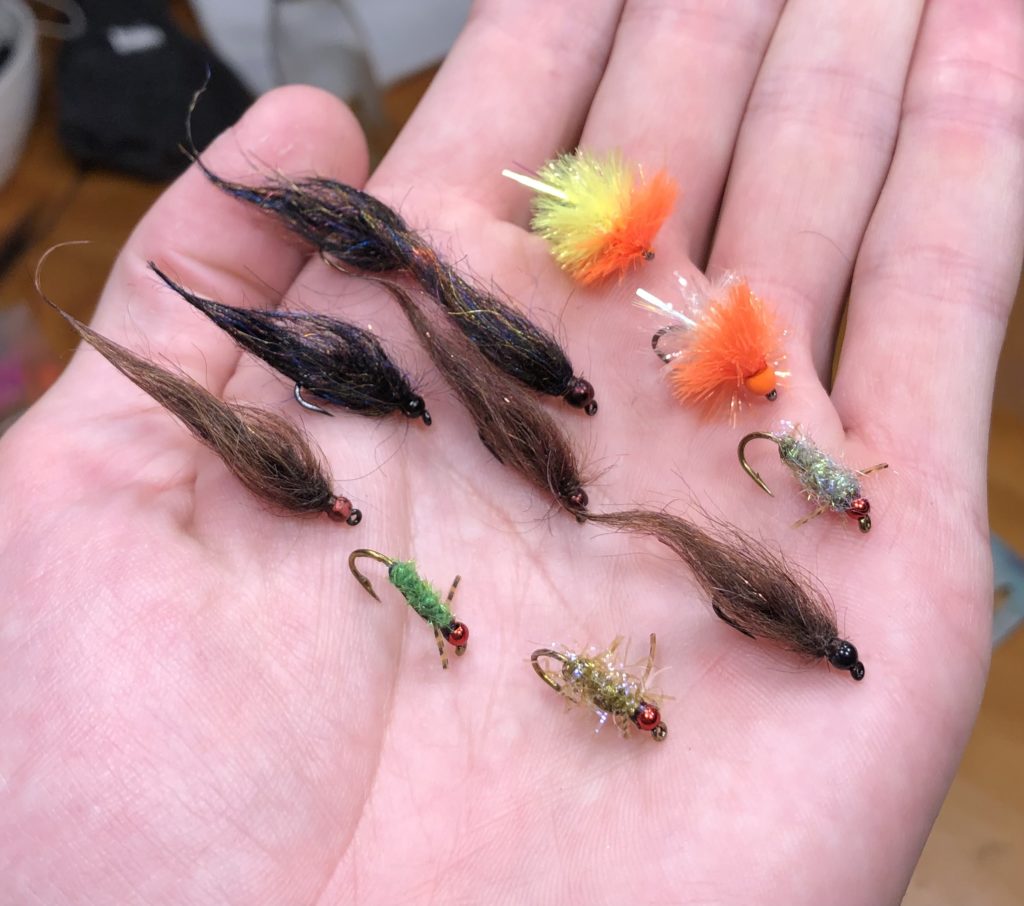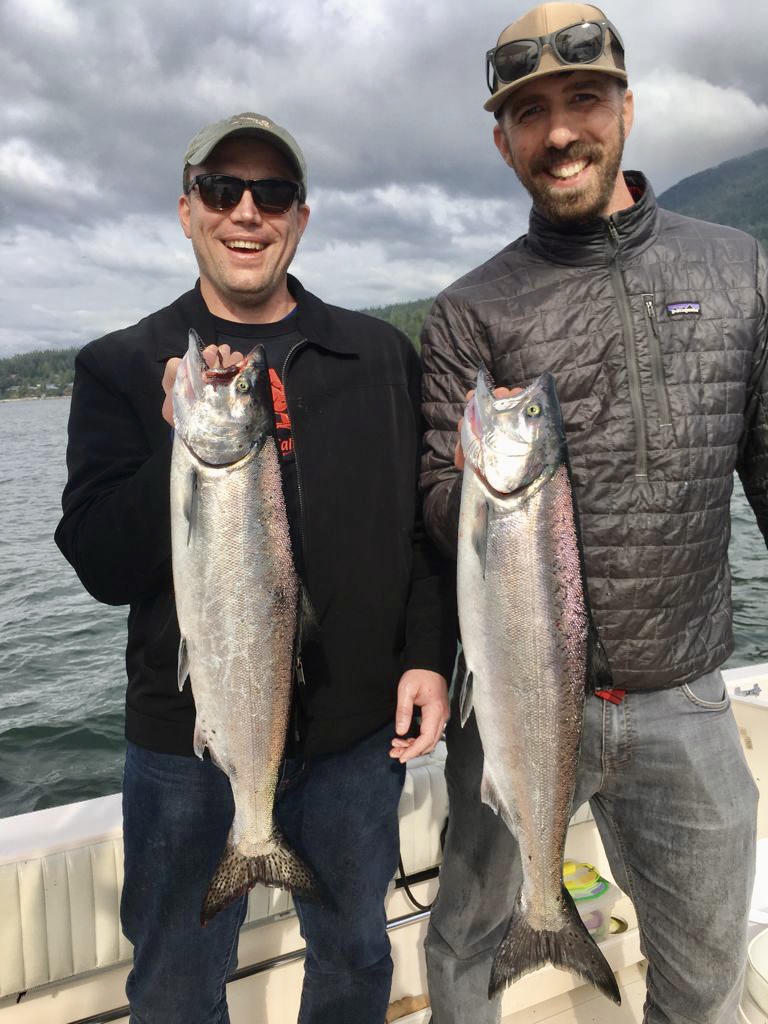OUTLOOK
River salmon fishing is in full swing. After last week’s rain and the rivers settled, we had good reports from all major systems. We have details below in our freshwater fishing reports section but, in a nut shell, it’s go time. If you’re heading out of town this weekend for Thanksgiving, we have heard some good reports from the lakes in the interior. Sterling is heading up for a trip this weekend and has a write up on what he plans to fish with some pics of the flies he has been tying for the trip. Definitely worth checking out if you are getting out for some lake fishing in the next few weeks.
For our saltwater anglers, Jason is back with a saltwater report this week. He’s got updates on the Cap fishery as it winds down for the season and some thoughts on the upcoming winter chinook fishing season.
On the video front, Matt will be back next week with a fresh report but, if you missed it last week, Andre is doing a fly box give away. For more details you can check out last week’s video report for detail on how to enter.
As we head into the Thanksgiving Long Weekend a friendly reminder, we are open regular hours all weekend and closed on Monday October 11.
Thanksgiving Holiday Weekend Hours
Friday October 8 | 10AM – 7PM
Saturday October 9 | 10AM – 6PM
Sunday October 10 | 11AM – 5PM
Monday October 11 | Closed – Happy Thanksgiving
On to the report!
CLASSES AND COURSES
Fly Fishing For Salmon In Rivers
Fly fishing for salmon is one of the most exciting fisheries in the Lower Mainland. Let us teach you the techniques and the hot spots to catch salmon on the fly in our local rivers. In the 3hr evening seminar you will learn about rod, reel and line, sink tip, and fly selection. Then put the skills into practice during a fully guided day on the water where you will learn how to read water and swing the fly!
Zoom Seminar: Oct 13, 2021 Guided: Oct 16, 17, 23 or 24, 2021
Seminar Only Cost: $50.00+GST
Seminar & Guided Walk’n Wade Cost: $275.00+GST per angler,
Zoom Seminar Time: 6:30pm – 9:30pm
Guided: Full Day
Fly Fishing Egg Patterns
This course is designed to teach you the secrets to one of the most productive presentations in the BC fly fishermen’s arsenal; nymphing egg patterns. This deadly method can be used for different species of trout, char, and salmon. During a 3 hour evening seminar we will teach you key concepts, strategies, and gear that will give you a well-rounded foundation during the seminar portion of the class. Then you will put those skills into practice during a fully guided day on the water.
Hurry! Only 2 Spots Open
Zoom Seminar: Nov 17, 2021Guided Portion: Nov 20 or 21, 2021
Cost: $275.00+GST
Zoom Seminar Time: 6:30pm – 9:30pm
Guided: Full Day
FRESHWATER FISHING REPORTS
Capilano River Fishing Report
Finally, we have been having some consistent weather on the North Shore. With that said, fishing has started to plateau and will stay that way until we receive some more rain. At the time of writing, the river is sitting at a stable 1.4m which is very fishable. A lot of fish have moved into the system already and are getting a bit stale and tight lipped. Low light conditions such as first and last light are going to give anglers an extra edge towards success.
Float fishing with artificials such as beads, blades and jigs continue to be effective.
Fly fishing with sparse and flashy patterns such as Muddlers, Cali Neils and Andre’s custom patterns will be very effective on these picky fish. Having a good assortment of different patterns and sizes will keep these picky coho and chinook interested throughout the day.
Twitching jigs and running hardware have been quite effective with anglers finding most success in slower water. Some pools are quite deep and utilizing heavier jigs and spoons will help you get down. Jigs, spoons, and spinners in 3/8, 1/2, 5/8 have been productive.
We are expecting some rain this weekend and throughout next week, which looks promising and will hopefully bring in more fish and stir things around.
See you on the water or in the shop!
Gavin Lau
Vedder/Chilliwack River Fishing Report
The Vedder/Chilliwack system has come down from its last blowout and has stabilized at a very good level. As such, there are good numbers of coho and chinook spread thrVeoughout the entire system. Fishing has been good, but somewhat spotty at times. With all the high water we’ve already seen this year, fish have been moving up much more quickly than in the past few years, so finding them has been hit-or-miss for some folks.
All the usual gear has been producing fish, with water conditions and targeted species being the biggest determining factor in what you’ll be using. Once again, there’s a fair amount of rain in the 7-day forecast as of writing this report, so it’ll probably be a good idea to have some larger presentations rigged up and ready to go. Roe, shrimp, hard beads, gooey bobs, wool and Colorado blades are all great options for float fishing for coho and chinook, but consider having some float fishing jigs as well, just in case the chum start rolling in as they should be showing up in numbers any day now. Spoons, spinners and twitching jigs are all very good options as well, if float fishing isn’t your thing. There aren’t many pinks around at this point, so it’s not worth heading out there looking for them- but keep in mind that pink is actually a very good colour for coho, chinook and chum as well, so don’t hesitate to give it a shot. You might be surprised at how well it’ll work.
We are now in what I would consider to be prime time for fall salmon in the Vedder, so now is the time to be out there, but please be mindful about where you wade. Try to avoid wading in the areas where spawning fish frequent, such as backchannels, tailouts and shallow, near-shore waters. There will be millions of pink eggs in these areas now that the pinks have successfully finished spawning.
Fresh salmon redds are easily identifiable as a patch of loose, clean-looking gravel, anywhere from 1-2 m2 in size. They will usually feature a “pot”, which is a depression in the gravel, followed by a “tail spill”, which is a fan of gravel downstream from the pot. Both will have hundreds or thousands of eggs buried in them, so do not step on them… squishing eggs is very counterproductive if you want to catch fish in a few years.
Taylor Nakatani
Stave River Fishing Report Primer
Well, it’s October and the Stave River Fall Salmon Season is upon us. Chum and coho salmon will be coming into the Stave over the next month and a half and this can be a fantastic fishery for both newcomers and hardcore anglers alike. While it is still a touch early there are some fish in the river now, with the runs peaking in the last week of October to first week of November.
The chum salmon fishery on this river can be extremely enjoyable as, during prime season, these fish are readily willing to bite and they put up a fantastic fight. The setup is a basic float fishing setup with a jig in any combination of purple, black, blue, chartreuse, pink, and fuchsia. Yes, I’m not kidding, any combination of these colours can be dynamite. If it’s a tough bite, tip your jig with a piece of prawn and that will get those fish going. Getting them on the fly is also very doable with intruders of the same colour combinations on a slow sink tip. On occasion, they will also hit spoons, beads, roe, and flash flies. The main thing to keep in mind is that these fish are big and feisty, so heavier rods and heavy line is recommended. Medium-heavy gear rods and 8-10wt fly rods with 12-15lb mono leader/tippet are the norm.
Coho salmon are the other dominant species in the Stave during the Fall. These fish are typically much smaller than the chum and as such tend to get pushed around a bunch. Hence, if you are catching a lot of chum you may want to relocate if you want to get on a coho bite. These fish also tend to stack up in the slack water along the side channels and typically will stage behind the chum, especially early in the season. You can get away with much lighter gear and smaller presentations. In addition, coho will hit a variety of cured roe, shrimp, spinners, spinners, twitching jigs, beads, colorado blades, flash flies, rolled muddlers, and mickey finns. Light to medium powered gear rods and 6-8weight fly rods are ideal with fluorocarbon leaders in the 6-10lb range. You want a presentation that slowly sinks, so intermediate sink tips and light lures are best.
Alex Au-Yeung
Squamish River Fishing Report
This past week saw a good push of fresh coho enter the system while trout and char fishing continues to be steady. That said, conditions may vary as different weather systems approach. As of writing this report, the systems are dropping and clearing, but this next week may see height and colour changes as rains come into both the Squamish and Whistler area.
Anglers fishing the mainstem will want to focus on slow and soft water considering its current height and colour. The fish will still push up and through but will rest and gather in the slower corners and troughs. Bigger spoons and spinners are a good idea, along with well-dressed twitching jigs. Beads, both soft and hard, have also produced char and rainbows when fished down stream of side channels or spawning/aging out salmon.
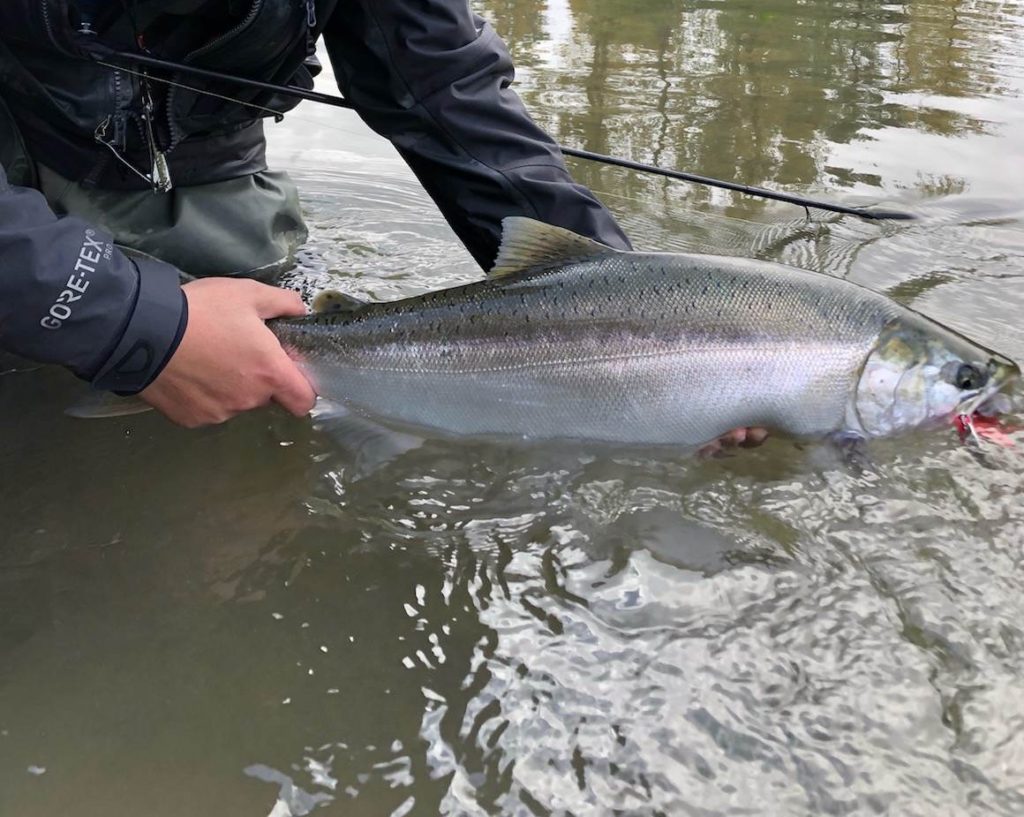
The tributaries to the Squamish, with the exceptions of those closed, have also been producing well lately for anglers looking to fish smaller systems. These systems usually hold their shape/colour better, but even then, it is a good idea to have a variety of presentations. Spoons, spinners, beads, and flies all find their share of fish for the anglers that are prepared.
At this time of year the fish also enter the system in waves, with each tide bringing or moving fresh fish. Don’t be scared to re-fish water you may have fished earlier in the morning/day, or the same water that was ‘dead and empty yesterday’.
On the egg eater front, there have been many instances where fish get put down with larger presentations, and those anglers with smaller 8mm and similar sized beads end up getting fish from generally quiet spots. Keeping hook size relative to bead/bob size is also important as you don’t want a hook that is too heavy to weight down an ‘egg’, but you also don’t want it too small or the diameter of your presentation can protect the hook point from sticking fish.
Experiment and explore, but be safe out there!
Jordan Simpson
STILLWATER FISHING REPORTS
Interior Lakes Fishing Report
Fall has come fast in the Interior as snow has begun to fall in many of the higher elevation lakes. The drop in temperature has caused many of those lakes to also drop into the sub-50 degree temperatures. This typically leads to two things. 1.) Fish continue to move shallow. 2.) Fish become a lot less bitey and lethargic. You’re likely to have an amazing day if you’re able to get a lot more of scenario 1 compared to scenario 2. This is the point where it’s common to have fish move into water as shallow as 2-3 feet. They’re trying to scrape together a leech, damsel, backswimmer, daphnia, and scud meal as much as they can before the hard water starts to form. The time to go is now if you’re debating whether to head up this weekend or next weekend since the fall fishing window seems to be closing fairly quickly.
I’ll be out of the shop for the next week as I go on my own interior trip. Check out some of the fly patterns I’ve tied up for my own personal trip if you’re looking for some inspiration.
Sterling Balzer
SALTWATER FISHING REPORTS
Vancouver Saltwater Salmon Fishing Report
The Cap Mouth has been slow this past week. There are still a few chinook and coho being taken, but for the most part the fish have moved up the river with those rains we had late September and early October. If you are looking for a quick flood tide fish, it’s worth a shot.
The coho numbers have been building in recent days in the Albion test sets as coho destined for rivers like the Vedder/Chilliwack and Chehalis are coming in. If you look at the test sets you will see there are a few chinook around as well. If you have the right sea conditions, the South Arm can be a good bet for hatchery coho and a chinook or two this time of year. The crowds are gone as well, which makes it a lot more fun to fish. Usually the coho are quite shallow, in the top 50 feet of the water column. You might get the odd chum as well. Looks like the chum numbers are going to be pretty low this year based on recent test set data I recently received.
Winter chinook fishing has been off to a strong start this year. Although we call it winter chinook fishing, the reality is these are feeder chinook or fish that will be feeding all fall and winter and spawning next fall. The usual spots in Howe Sound have been producing a few fish as have the Gulf Islands from the southern sections up to Gabriola.
This fishery normally has more participants from December onwards, but with Vancouver anglers not having access to chinook for 6 months in the spring and summer, there has been a distinct shift of more effort in September and now into October for feeder chinook.
This fishery is highly variable. If there is bait around there are usually a few fish around. No bait and its usually slow. Not rocket science but keep an eye on your sonar and move around to different spots until you find some bait. The fish are generally close to the bottom as well, so make sure you have plenty of cable and keep an eye on those rigger depths. You want to keep your gear within 10% of the bottom and make sure you are not in a sponge reef refuge.
In terms of reporting on actual fishing, there won’t be much of that going on in my reports this winter because this fishery changes incredibly fast. The fish are there one day and potentially gone the next. The best advice I can give you is to keep an eye on the weather and pick the days that are going to be the most enjoyable to fish. You have 6 months of this, so you can get a bit picky!
See you in the shop or on the water!
Jason Tonelli


